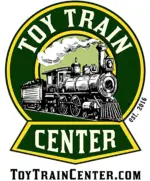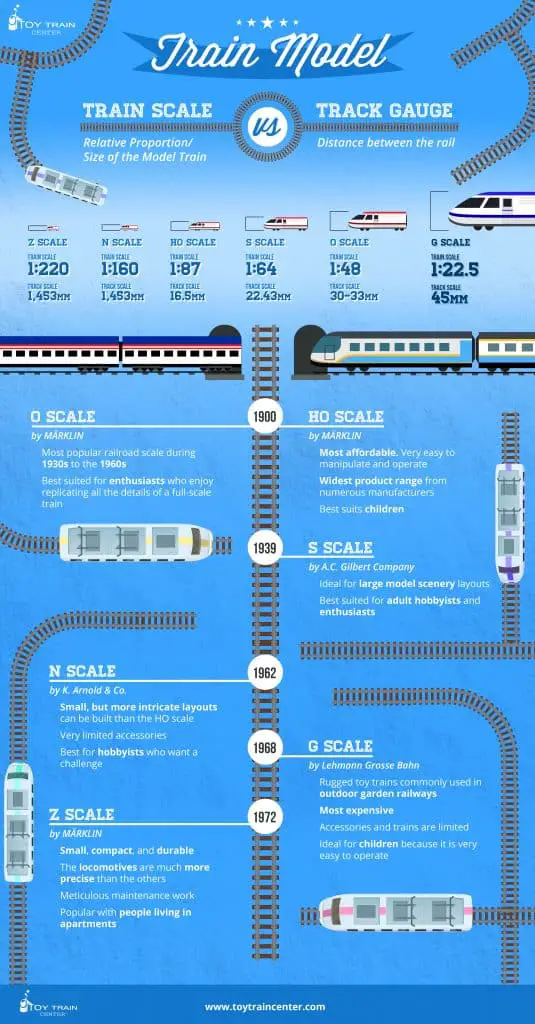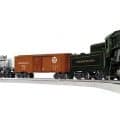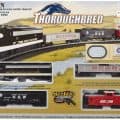It is often a debate for train hobbyist or enthusiast if which model train scale is the best. That is also a major concern for a beginner or starter in model trains. The train sets or model trains do not come cheap. It usually has a reasonable price that comes with its purpose, quality, durability, and features. You wouldn’t want to buy a certain model train and not be satisfied with the results. It is to your best advantage to have some knowledge about the different types or scales of model trains that really suits your preference. That way, you wouldn’t exert some extra time, money and effort in obtaining one.
For simple analysis, jump right through the details below with this brief and concise trainfographic below!
Share this Image On Your Site
The usual mistake of newbies when it comes to model trains is caused by a wide confusion when it comes to choosing a scale. Train models are scaled down to a standard measurement that replicates the actual train locomotive. A good example would be the HO scale train set as it is the most common of them all. The HO scale has a standard measurement of 1/87 where 1 is the ratio of the model train and the actual train locomotive is 87 times larger than the model train.
Owning a toy train set is very rewarding for you and your family. With the right toy train set, you can bond and interact with each other; You can build something together.
We can’t tell you what the best toy train set is, however, we can help you find out for yourself what is the best toy train set for you and your family. Model toy train sets come in various designs, gauges, and scales. Before you buy a toy train set, you have to know the basics, know the different models, and know which model is best for you and your family.
Which Model Train Scale Is The Best?
Scale versus Gauge
Scale is the ratio of the toy train set to the real-life train prototype, while the distance between the rails of the track is the “Gauge”.
A gauge is quite easy to understand, and always remember, the trains and the track gauge should be compatible with each other. Each train scale has a corresponding track gauge. Gauges can generally be Narrow or Broad. Broad gauges are faster than Narrow gauges. Broad gauge tracks can also support bigger and heavier train cars. However, Narrow gauge tracks are cheaper and less demanding in terms of the right of way. You can use Narrow gauges on different terrains. You can use it to build tunnels and bridges.
As for the scale, a better way to understand it is to visualize an actual train. This train has specific measurements and a toy train is a scaled down version of this actual train. It will have smaller measurements but the proportion of these measurements will be the same as the actual. Each scale works with a corresponding gauge. For example, certain types of train cars cannot be carried by a narrow Gauge. A smaller train scale will naturally require a narrower track gauge. A larger train scale, consequently, will require a broader track gauge.
The thought does not really imply to the overall size of the scale of the train. The best model train scale is subjective to the person’s preferences. The idea here is to give you an insight about each scale of model trains so that you can perceive which of them would be the best for you.
Below is a short guide about model railway scales and gauges as well as the scale ratio of each train model type on the following:
It briefly explains all the necessary things you need to know about model train gauges and scales in a summarized video.
Z scale 1:220
The Z-scale model train has a minimum radius of 5.75 in. This scale is the smallest of all scales. The way this train model was miniaturized is actually remarkable. It is a work of art. The train model being small and compact also makes it highly durable. The train model, however, makes it hard to clean, maintain or re-paint. There are some areas that can be hard to cover or reach, especially when using an air brush.
The Z Scale was introduced by the German manufacturing company Gebr. Märklin & Cie. GmbH (or simply MÄRKLIN) in 1972 and it was considered to be the smallest commercially available train scale at that time. It was considered to be the niche scale as far as the United Kingdom is concerned. It has a scale of 1.385 millimeter to 1 foot and its Scale ratio is 1:220. The model gauge of the Z Scale is 6.5 millimeters over 0.256 inches while its prototype gauge is 1,453 millimeter or 4 feet and 8.5 inches.
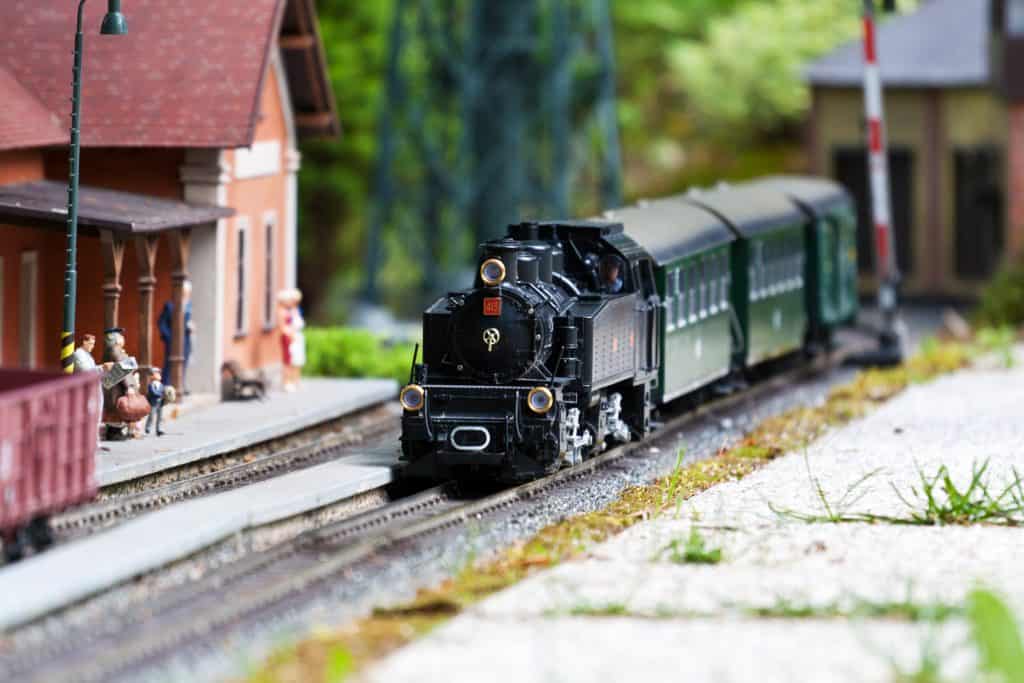
Z Scale is ideal for persons with limited spaces; It is popular with people living in apartments, condominiums, and small houses. If you are thinking of adding one to your office, this might be the toy train scale for you.
Today, the Z Scale is the fastest growing scale in model railroading. The way this train model was miniaturized is absolutely remarkable—it is definitely a work of art! The train model is so small and compact, but it is also highly durable.
While the Z Scale has limited variety compared to the N Scale which has cheaper parts, the former’s engines are relatively more expensive because of the tiny parts that go into them and their general overall engineering. The locomotives in a Z Scale are much more precise than the others.
A known downside for this type of toy train scale is that its size makes it difficult to clean, maintain, or re-paint. There are some areas that can be hard to cover or reach, especially when using an airbrush.
The Z Scale is best suited for people who are patient and who do not mind the meticulous work that comes with maintaining it. This type of scale also attracts people who prioritize the quality of the locomotives.
N scale 1:160
This scale train model has a ratio of 1:160 the original size of the train locomotive. This is still considered as a small train model scale. But somehow it is much easier to clean and maintain. Both the Z-scale and the N-scale train model are best suited for people who do not have a wide area for their train layout or does not have a layout large enough for larger scale train models. It is very unpleasing to watch a large scale train model running on a small model scenery layout and vice versa.
The N Scale toy train model was first launched by the K. Arnold & Co. in Nuremberg in 1962. It has a worldwide following. Its scale ratio ranges from 1:148 to 1:160. The N Scale’s track gauge is 9 millimeters or about 0.354 inches, while its prototype gauge is 1,453 millimeter or 4 feet and 8.5 inches, which is the standard gauge. This is similar to what the Z Scale has.
DC motors are responsible for powering the locomotives of this Scale. These locomotives accept a maximum power amounting to 12 V DC. The train speed in traditional DC control is determined by the voltage amount supplied to its rails.
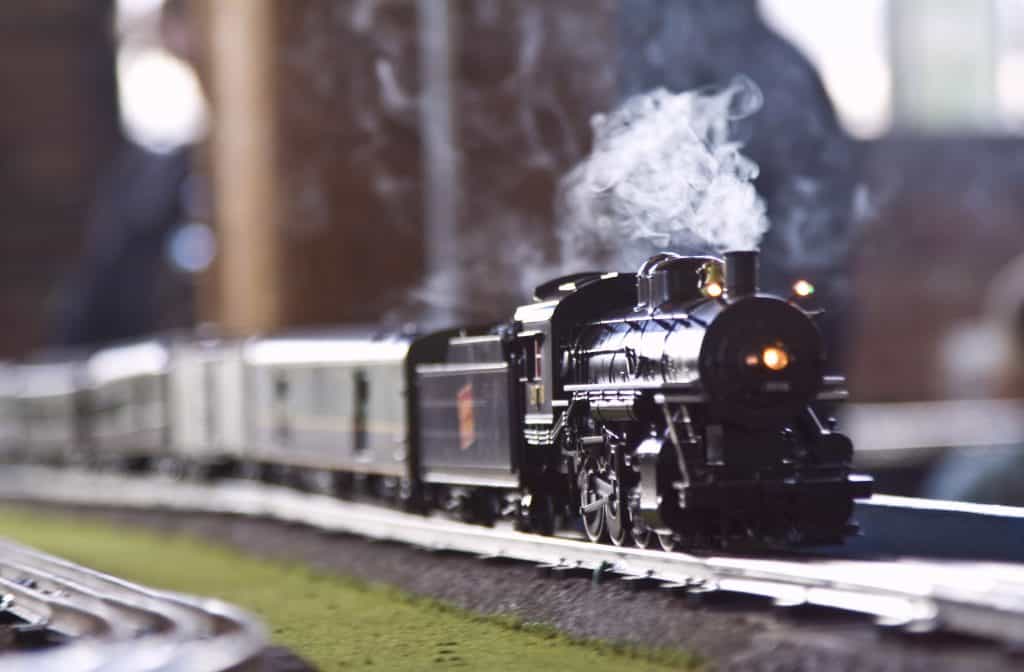
Even though it is still considered as a small scale type, it is bigger than the Z Scale. The N Scale enjoys the benefits of a small scale toy train model like the Z Scale but it is easier to clean and maintain compared to the Z Scale.
People are usually torn between the N Scale and the HO Scale. At the end of the day, a lot of modelers select the N Scale instead of the HO Scale, though. This is because the N Scale allows more complicated layouts to be built. The only downside is that the N Scale is often more challenging for young users and even for hobbyists because it can be difficult to manipulate the small rolling stock. There are also very limited choices when it comes to accessories in comparison to the variety of accessories available in other scales like the HO Scale.
The N Scale train model is best suited for people who do not have a wide area for their train layout or does not have a layout large enough for larger scale train models.
HO scale 1:87
The HO scale is the widely known scale type in most train model sets. It has a fair size/ratio of 1:87 where 87 is the actual size of the train locomotive. This is the type of train model scale which suits young children perfectly. It is very easy for kids to manipulate and operate the train model set compared to larger or smaller scales. The HO scale train set also has the most parts available in the market, making it easier for people to replace, repair or purchase an additional set of their existing ones. It has the right size where people can really appreciate the detail, not so big as it brings an intense impression on the detail and not so small that you could barely see any.
The HO Scale obtained its name from the fact that this scale is“half” that of the O Scale which is 1:87. This scale used to be the smallest of the series of larger and older 0, 1, 2 and 3 gauges made by MÄRKLIN in 1900.
Known to have the widest product range from a great number of manufacturers, the HO Scale is easy to build. It has a scale of 3.5 millimeters to 1 foot. Its scale ratio is 1:87. It has a model gauge of 16.5 millimeters or 0.65 inches and it also has a standard prototype gauge similar to that of the Z Scale and N Scale.
The HO Scale models are usually less pricey than that of the other smaller scale models. This is due to the fact that the manufacturing processes in Z and N are more exacting. The HO Scale is also more affordable than the S, O and G Scales because HO Scales use a smaller amount of material.
The HO Scale’s popularity and its resultant economy help in keeping this scale’s price low. This type of train set scale also has the most parts available in the market, making it easier for people to replace, repair or purchase an additional set of their existing ones. It has the right size where people can really appreciate it. It is not too big, but, it is also not too small that you could barely see the details.
This is the type of train model scale which suits young children perfectly. It is very easy for kids to manipulate and operate the HO Scale toy train model set.
OO scale 1:76
From hereon then, the difference in size of each train scale really does not differ far apart. The OO scale has 1:76 ratio and a minimum radius of 21, that’s just a few measurement ahead of the HO scale which has 1:87 scale ratio and a minimum radius of 15. The size also brings the same appreciation like with the HO scale. It’s just within the right size that you can see and appreciate all the details of the train model. The model, parts, and accessories, however, is not that abundant compared to the HO scale.
S scale 1:64
The S scale has a scale ratio of 1:64. This is one large close to the largest scale model train. This is ideal for adult hobbyist and enthusiast. The scale does not bring any difficulty for adults to operate the train model set. It does, however, bring discomfort for young children wherein the HO scale still is the best model trains scale for that age range. The S scale brings out the details of the train model on a much broader scale. You can really appreciate the train set if being laid unto a large model scenery layout.
The S Scale is one of the oldest models for railroading scales. In 1896, the very first known 1:64 scale train was built from card. In the early 20th century, the first working models was introduced in England. S Scale trains were brought as American Flyer products to the market of model railroad by the A.C. Gilbert Company in 1939. The S Scale toy train set has a scale of 0.1875 to 1 foot a scale ratio of 1:64. Its model gauge is 0.883 inches or 22.43 millimeters and also has a standard prototype gauge. A lot of varieties of trains in this Scale are manufactured in both AC and DC.
The S Scale railroading almost became extinct but it gained its popularity back in the last two decades.

The S Scale is 36 percent larger than the HO Scale. The S Scale is in between the O and HO Scales in terms of size. The size of this Scale is considered to be the optimum size because it enjoys the pros of both the HO and O scales while leaving behind both of these scales’ cons.
Adults won’t find it difficult to set up and operate the S Scale toy train set. Children will, however, find it a challenge to handle. The S Scale may be too complicated for them.
It is important to note that people usually confuse the S Scale train and the toy train standard gauge. The latter is a large-scale standard for toy trains which was introduced in the early part of the 20th century. The S Scale brings out the details of the train model on a much broader scale. You can really appreciate this train set if it is laid onto a large model scenery layout.
This Scale is best suited for adult hobbyists and enthusiasts.
O scale 1:48
This the largest of all the scale model trains sets. It has a ratio of 1:48 and a radius minimum of 24 inches. The O scale and the HO scale really fit each other if put in comparison. The HO scale size is about half the O scale wherein you can reduce your measurement to half from O to HO and double it from HO to O when it comes to train model scenery to replicate one or the other. You can easily upgrade or transition from HO scale to O scale as it does not require you a hard calculation when it comes to measuring your model scenery designs.
The O Scale refers to a model railroad train that is 1/48th the size of a real train in the United Kingdom. O Scale trains are generally 1/43rd the size of the real thing while in Europe they are 1/45th as big. This scale is most often used for rail transport modeling and for toy train sets. MÄRKLIN originally introduced this Scale around 1900 and from the 1930s to the 1960s, the current O Scale was considered the most popular railroad scale in the United States.
The O Scale has a scale of 6.35 millimeters or 7 millimeters to 1 foot. It has various scale ratios ranging from 1:48 to 1:43.5. Its model gauge is 30 millimeters to 33 millimeters and it also has a standard prototype gauge like the rest of the scales discussed.
The O Scale and the HO Scale really fit each other if put together. The HO Scale size is about half the O Scale wherein it is possible to reduce the measurement in half from O to HO and double it from HO to O when it comes to train model scenery to replicate one or the other. An upgrade or transition from HO Scale to O Scale is easily done as it does not require a hard calculation when it comes to measuring your model scenery designs.
This scale is best suited for enthusiasts who enjoy replicating all the details of a full-scale train. It can be a difficult task so this is not the best train set for children or for first timers.
To give you some of the basics of train models, here is a short video:
It is important to know what train scale is best suited for your taste or preference. This will save you a large amount of money and effort as most of this model trains does not come cheap.
Additional Scale – G Scale 1:22.5
On the later years of model trains, the G scale was introduced, making the O scale the second largest if included in standard scaling. The G scale has a ratio of 1:22.5. But it does not usually appear on the train model set scales as it is an outdoor train model. It also requires such amount of effort in installation, not fitting for a hobbyist or enthusiast.
The G Scale train scale was introduced in the 1960s by Lehmann Grosse Bahn. It has a scale ratio of 1:22.5. Its model gauge is 45 millimeters or 1.772 inches. The G Scale is different from the other scales because its prototype gauge is not the standard gauge. Instead, it has meter gauge of 1,000 millimeters or 3 foot and 3.375 inches.
These rugged toy trains are commonly used in outdoor garden railway designs. The G Scale is a model wherein hobbyists can combine their love of trains, gardens, waterfalls, and ponds. You can build your railroads on a landscaped terrain with a G Scale. The main downside of this is that it takes up a lot of room. The choice for different trains and accessories are limited as well.
G Scale model trains range from 1:24 scale to 1:32 scale. This depends on the manufacturer of the model, but in general, both scales run on the same gauge track together. A good variety of European and North American models are in the market.
While it is true that a lot of manufacturers do not base the size of models on the same scale, the differences in size are often not much of an issue as long as they have compatible couplers. They will still work the same.
G gauge trains are quite common. It can be purchased from many hobby shops and toy stores. It also won’t be difficult to find G Scale toy train models online and have it delivered to your doorstep. When it comes to the costs, the G Scale’s quality engines, rolling stocks, tracks, and accessories can get very expensive compared to the other scales.
This scale is ideal for children and first timers because it is very easy to operate. They rarely derail and many of the equipment made in G Scale is suitable for outside use.
Making Your Decision
You must know now that there are many toy train scale models to choose from and each has its own pros and cons. You have to take into consideration your budget, available space, who will be involved, the design you want, etc.
Toy trains are for everyone, but as you may already know, there are many toy train scales ideal for children, such as the G Scale and the HO Scale. Skill is also a factor in choosing toy train scales. Experts may enjoy building S Scale train sets the most; An HO Scale might be too boring for adult hobbyist and enthusiasts.
To further understand the basics of model train gauges and scales and to know each set’s difference, watch the short video below:
Here’s another tip: Set a budget. For example, a G Scale is more expensive than the other scales, but other toy train models using a different train scale can be more expensive in terms of total costs. You have to take into account the layout, and what kind and how many train cars you intend to buy. Your budget is not defined by the scale alone. A simple G Scale toy train model can cost lesser than a bigger HO Scale complete with animated accessories. Remember to be realistic when setting your budget and planning your toy train model. Do not forget to take into consideration the resources available to you, the space you plan to build your toy train model on, the design or theme that you have in mind. If you are living in an apartment, it’s best to build a Z Scale. If you plan to have a big layout, make sure that you have enough trains so that it won’t look empty. It doesn’t matter what scale you choose. No train scale is better than the others. It’s your careful planning and creativity that makes the difference.
While it is easier to buy your children a new video game and joining them for a game or two, building something together with your own hands is a more fulfilling activity. Involve your children as early as the planning stage. Teach them the basics of toy train models. Making them understand the different toy train scales is a good start. The more they understand, the more they will appreciate. The more they appreciate, the more they will enjoy building toy train models with you. Unlike video games, toy trains are something concrete, something anyone can see and marvel at any time of the day—absolutely a good decoration in any home and a proof of your bond as a family; A legacy that will be passed from generation to generation.
